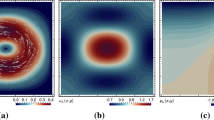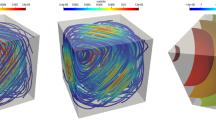Abstract
We consider a pressure-stabilized Lagrange–Galerkin scheme for the transient Oseen problem with small viscosity. In the scheme we use the equal-order approximation of order k for both the velocity and pressure, and add a symmetric pressure stabilization term. We show an error estimate for the velocity with a constant independent of the viscosity if the exact solution is sufficiently smooth. We also show an error estimate of a discrete primitive of the pressure. Numerical examples show high accuracy of the scheme for problems with small viscosity.








Similar content being viewed by others
References
Achdou, Y., Guermond, J.L.: Convergence analysis of a finite element projection/Lagrange–Galerkin method for the incompressible Navier–Stokes equations. SIAM J. Numer. Anal. 37(3), 799–826 (2000)
Becker, R., Braack, M.: A finite element pressure gradient stabilization for the Stokes equations based on local projections. Calcolo 38(4), 173–199 (2001)
Benzi, M., Golub, G., Liesen, J.: Numerical solution of saddle point problems. Acta Numer. 14, 1–137 (2005)
Bermejo, R., Saavedra, L.: A second order in time local projection stabilized Lagrange–Galerkin method for Navier–Stokes equations at high Reynolds numbers. Comput. Math. Appl. 72(4), 820–845 (2016)
Bochev, P., Dohrmann, C., Gunzburger, M.: Stabilization of low-order mixed finite elements for the Stokes equations. SIAM J. Numer. Anal. 44(1), 82–101 (2006)
Boffi, D., Brezzi, F., Fortin, M.: Mixed Finite Element Methods and Applications. Springer, Berlin (2013)
Brezzi, F., Fortin, M.: A minimal stabilisation procedure for mixed finite element methods. Numer. Math. 89(3), 457–491 (2001)
Brezzi, F., Pitkäranta, J.: On the stabilization of finite element approximations of the Stokes equations. In: Hackbusch, W. (ed.) Efficient Solutions of Elliptic Systems, pp. 11–19. Vieweg, Wiesbaden (1984)
Burman, E.: Pressure projection stabilizations for Galerkin approximations of Stokes’ and Darcy’s problem. Numer. Methods Partial Differ. Equ. 24(1), 127–143 (2008)
Burman, E., Fernández, M.A.: Continuous interior penalty finite element method for the time-dependent Navier–Stokes equations: space discretization and convergence. Numer. Math. 107(1), 39–77 (2007)
Burman, E., Fernández, M.A.: Galerkin finite element methods with symmetric pressure stabilization for the transient Stokes equations: stability and convergence analysis. SIAM J. Numer. Anal. 47(1), 409–439 (2009)
Ciarlet, P.G.: The Finite Element Method for Elliptic Problems, Classics in Applied Mathematics, vol. 40. SIAM, Philadelphia (2002)
Clément, P.: Approximation by finite element functions using local regularization. RAIRO Anal. Numér. 9(2), 77–84 (1975)
De Frutos, J., García-Archilla, B., John, V., Novo, J.: Grad-div stabilization for the evolutionary Oseen problem with inf-sup stable finite elements. J. Sci. Comput. 66(3), 991–1024 (2016)
De Frutos, J., García-Archilla, B., John, V., Novo, J.: Error analysis of non inf-sup stable discretizations of the time-dependent Navier–Stokes equations with local projection stabilization. IMA J. Numer. Anal. (2018). https://doi.org/10.1093/imanum/dry044
Dohrmann, C.R., Bochev, P.B.: A stabilized finite element method for the Stokes problem based on polynomial pressure projections. Int. J. Numer. Methods Fluids 46(2), 183–201 (2004)
Douglas Jr., J., Russell, T.: Numerical methods for convection-dominated diffusion problems based on combining the method of characteristics with finite element or finite difference procedures. SIAM J. Numer. Anal. 19(5), 871–885 (1982)
Douglas Jr., J., Wang, J.: An absolutely stabilized finite element method for the Stokes problem. Math. Comput. 52, 495–508 (1989)
Franca, L., Stenberg, R.: Error analysis of some Galerkin least squares methods for the elasticity equations. SIAM J. Numer. Anal. 28(6), 1680–1697 (1991)
Glowinski, R., Le Tallec, P.: Augmented Lagrangian and Operator-Splitting Methods in Nonlinear Mechanics. SIAM, Philadelphia (1989)
Hecht, F.: New development in FreeFem++. J. Numer. Math. 20(3–4), 251–265 (2012)
Heywood, J.G., Rannacher, R.: Finite-element approximation of the nonstationary Navier–Stokes problem. Part IV: error analysis for second-order time discretization. SIAM J. Numer. Anal. 27(2), 353–384 (1990)
Hughes, T.J.R., Franca, L.P., Balestra, M.: A new finite element formulation for computational fluid dynamics: V. Circumventing the Babuška–Brezzi condition: a stable Petrov–Galerkin formulation of the Stokes problem accommodating equal-order interpolations. Comput. Methods Appl. Mech. Eng. 59(1), 85–99 (1986)
Jia, H., Li, K., Liu, S.: Characteristic stabilized finite element method for the transient Navier–Stokes equations. Comput. Methods Appl. Mech. Eng. 199(45–48), 2996–3004 (2010)
John, V., Knobloch, P., Novo, J.: Finite elements for scalar convection-dominated equations and incompressible flow problems: a never ending story? Comput. Vis. Sci. 19(5–6), 47–63 (2018)
John, V., Linke, A., Merdon, C., Neilan, M., Rebholz, L.: On the divergence constraint in mixed finite element methods for incompressible flows. SIAM Rev. 59(3), 492–544 (2017)
John, V., Novo, J.: Analysis of the pressure stabilized Petrov–Galerkin method for the evolutionary Stokes equations avoiding time step restrictions. SIAM J. Numer. Anal. 53(2), 1005–1031 (2015)
Laursen, M.E., Gellert, M.: Some criteria for numerically integrated matrices and quadrature formulas for triangles. Int. J. Numer. Methods Eng. 12(1), 67–76 (1978)
Notsu, H.: Numerical computations of cavity flow problems by a pressure stabilized characteristic-curve finite element scheme. Trans. Jpn. Soc. Comput. Eng. Sci. (2008). ONLINE ISSN: 1347-8826
Notsu, H., Tabata, M.: A combined finite element scheme with a pressure stabilization and a characteristic-curve method for the Navier–Stokes equations. Tran. Jpn. Soc. Ind. Appl. Math. 18(3), 427–445 (2008). (in Japanese)
Notsu, H., Tabata, M.: Error estimates of a pressure-stabilized characteristics finite element scheme for the Oseen equations. J. Sci. Comput. 65(3), 940–955 (2015)
Notsu, H., Tabata, M.: Error estimates of a stabilized Lagrange–Galerkin scheme for the Navier–Stokes equations. ESAIM Math. Model. Numer. Anal. 50(2), 361–380 (2016)
Olshanskii, M., Reusken, A.: Grad-div stablilization for Stokes equations. Math. Comput. 73, 1699–1718 (2004)
Pironneau, O.: On the transport-diffusion algorithm and its applications to the Navier–Stokes equations. Numer. Math. 38(3), 309–332 (1982)
Rui, H., Tabata, M.: A second order characteristic finite element scheme for convection-diffusion problems. Numer. Math. 92(1), 161–177 (2002)
Silvester, D.: Optimal low order finite element methods for incompressible flow. Comput. Methods Appl. Mech. Eng. 111(3–4), 357–368 (1994)
Süli, E.: Convergence and nonlinear stability of the Lagrange–Galerkin method for the Navier–Stokes equations. Numer. Math. 53(4), 459–483 (1988)
Tabata, M., Uchiumi, S.: A genuinely stable Lagrange–Galerkin scheme for convection-diffusion problems. Jpn. J. Ind. Appl. Math. 33(1), 121–143 (2016)
Tabata, M., Uchiumi, S.: An exactly computable Lagrange–Galerkin scheme for the Navier–Stokes equations and its error estimates. Math. Comput. 87, 39–67 (2018)
Tanaka, K., Suzuki, A., Tabata, M.: A characteristic finite element method using the exact integration. Annu. Rep. Res. Inst. Inf. Technol. Kyushu Univ. 2, 11–18 (2002). (in Japanese)
Acknowledgements
The author is thankful to anonymous reviewers for their valuable comments that improve this paper. The author would like to express his gratitude to Professor Emeritus Masahisa Tabata of Kyushu University for valuable discussions and encouragements. This work was supported by Japan Society for the Promotion of Science (JSPS) under Grant-in-Aid for JSPS Fellows, No. 26\(\cdot \)964, and under the Japanese-German Graduate Externship (Mathematical Fluid Dynamics), and by CREST, Japan Science and Technology Agency.
Author information
Authors and Affiliations
Corresponding author
Additional information
Publisher's Note
Springer Nature remains neutral with regard to jurisdictional claims in published maps and institutional affiliations.
A Estimates for LG Schemes
A Estimates for LG Schemes
Lemma 6 is shown in [39, Lemma 5.7].
Lemma 6
Let \(w^*\in W^{1,\infty }(\varOmega )^d\) and \(X_1(w^*)\) be the mapping defined in (4). Under the condition \(\Delta t |w^*|_{1,\infty } \le 1/4\), the estimate
holds, where \(\det (\partial X_1(w^*)/\partial x)\) is the Jacobian of \(X_1(w^*)\).
Lemma 7 is shown in [35, Lemma 1].
Lemma 7
Let \(w^*\in W^{1,\infty }_0(\varOmega )^d\) and \(X_1(w^*)\) be the mapping defined in (4). Under the condition \(\Delta t|w^*|_{1,\infty } \le 1/4\), there exists a positive constant c independent of \(\Delta t\) such that for \(v \in L^2(\varOmega )^d\)
We now show an estimate for \(R_1^n\) in Lemma 8, or tools for estimating \(R_2^n\) and \(R_3^n\) in Lemmas 9 and 10, where \(R_i^n\), \(i=1,2,3\), are defined in (16). Although these estimates are frequently used in the analysis of the LG method, e.g. [31, 39], we show proofs of Lemmas 8 and 10 for completeness.
Lemma 8
Suppose that \(u\in Z^2\), \(w \in C(W^{1,\infty }_0) \cap H^1(L^\infty )\) and \(\Delta t |w|_{C(W^{1,\infty })} \le 1/4\). Then
Proof
We estimate \(\Vert R_1^n \Vert _0\) by dividing
For \(R_{11}^n\), we set
and use Taylor’s theorem to get
Using the property of the Bochner integral, we then have
where we have used the transformation of independent variables from x to y and s to t, and the estimate \(|\det (\partial x/\partial y)| \le 2\) by virtue of Lemma 6. It is easy to show
Combining the two estimate, we have the conclusion. \(\square \)
Lemma 9 is a direct consequence of [1, Lemma 4.5] and Lemma 6.
Lemma 9
Let \(1\le q <\infty \), \(1\le p \le \infty \), \(1/p+1/p'=1\) and \(w_i\in W_0^{1,\infty }(\varOmega )^d\), \(i=1,2\). Under the condition \(\Delta t |w_i|_{1,\infty }\le 1/4\), it holds that, for \(v \in W^{1,qp'}(\varOmega )^d\),
where \(X_1(\cdot )\) is defined in (4).
Lemma 10
Suppose that \(v \in H^1(H^1)\), \(w^*\in W^{1,\infty }_0(\varOmega )^d\), and \(\Delta t |w^*|_{1,\infty } \le 1/4\). Then
where \(X_1(\cdot )\) is defined in (4).
Proof
Similar to the proof of Lemma 8, by defining
and by using the property of the Bochner integral, we have the estimate
The conclusion follows from the transformation of the independent variables from x to y and s to t, and the estimate \(|\det (\partial x/\partial y)| \le 2\) by virtue of Lemma 6. \(\square \)
Lemma 11 is an extension of [17, Lemma 1] obtained in the 1D case.
Lemma 11
Let \(w^*\in W_0^{1,\infty }(\varOmega )^d\). Under the condition \(\Delta t |w^*|_{1,\infty }\le 1/4\), there exists a positive constant c independent of \(\Delta t\) such that, for \(v \in L^2(\varOmega )^d\),
where \(X_1(\cdot )\) is defined in (4) and \(\Vert \cdot \Vert _{-1}\) is the norm in \(H^{-1}\).
Rights and permissions
About this article
Cite this article
Uchiumi, S. A Viscosity-Independent Error Estimate of a Pressure-Stabilized Lagrange–Galerkin Scheme for the Oseen Problem. J Sci Comput 80, 834–858 (2019). https://doi.org/10.1007/s10915-019-00958-7
Received:
Revised:
Accepted:
Published:
Issue Date:
DOI: https://doi.org/10.1007/s10915-019-00958-7
Keywords
- Transient Oseen problem
- Lagrange–Galerkin scheme
- Finite element method
- Equal-order elements
- Symmetric pressure stabilization
- Dependence on viscosity




